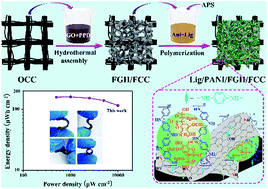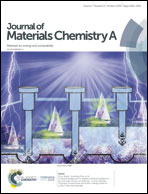A new strategy for anchoring a functionalized graphene hydrogel in a carbon cloth network to support a lignosulfonate/polyaniline hydrogel as an integrated electrode for flexible high areal-capacitance supercapacitors†
Abstract
Carbon cloth (CC) is widely used as a freestanding substrate for energy storage devices, due to its high conductivity, special porous network, and good mechanical flexibility. However, it is still challenging to fully utilize the space of CC to achieve a high mass loading of electroactive materials and ultimately fulfill high electrochemical performance. Herein, a new strategy is proposed to fill the gaps and voids in CC with a functionalized graphene hydrogel (FGH) through one-step hydrothermal treatment of oxidized CC submerged in a mixture of graphene oxide and p-phenylenediamine. The as-prepared FGH/functionalized CC is then adopted as a scaffold to load a lignosulfonate/polyaniline (Lig/PANI) hydrogel via in situ polymerization of aniline in the presence of lignosulfonate, and thereby an integrated textile (Lig/PANI/FGH/FCC) is obtained. The symmetric supercapacitor assembled with Lig/PANI/FGH/FCC electrodes and 1 M H2SO4 electrolyte shows a superior areal capacitance of 1223 mF cm−2 and an energy density of 169.9 μW h cm−2 at 2 mA cm−2. Moreover, the assembled flexible all-solid-state supercapacitor presents competitive energy density (160.6 μW h cm−2 at 1000 μW cm−2) and excellent flexibility. This design of anchoring a hierarchical porous conductive network in a macroscopic macropore framework paves a new avenue towards high mass loading and low interfacial resistance in macroporous material-based electrodes for high-performance energy storage devices.



 Please wait while we load your content...
Please wait while we load your content...